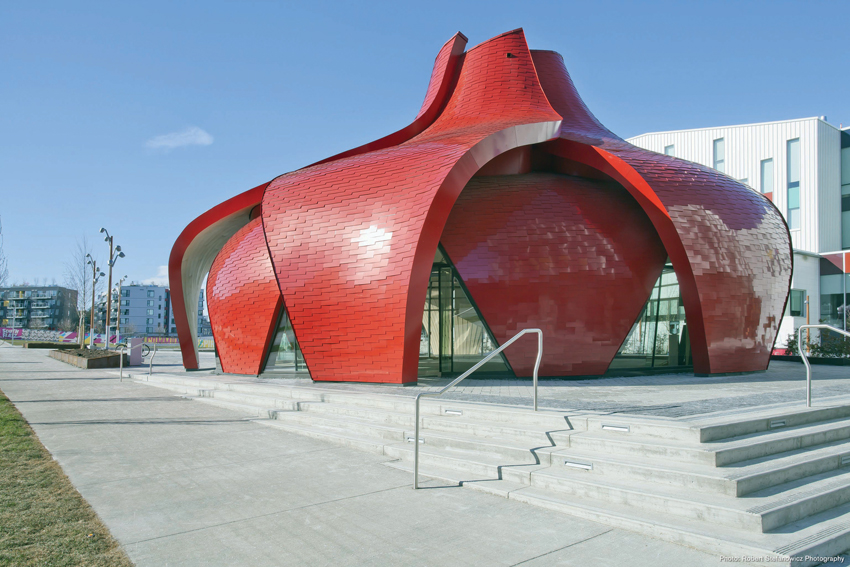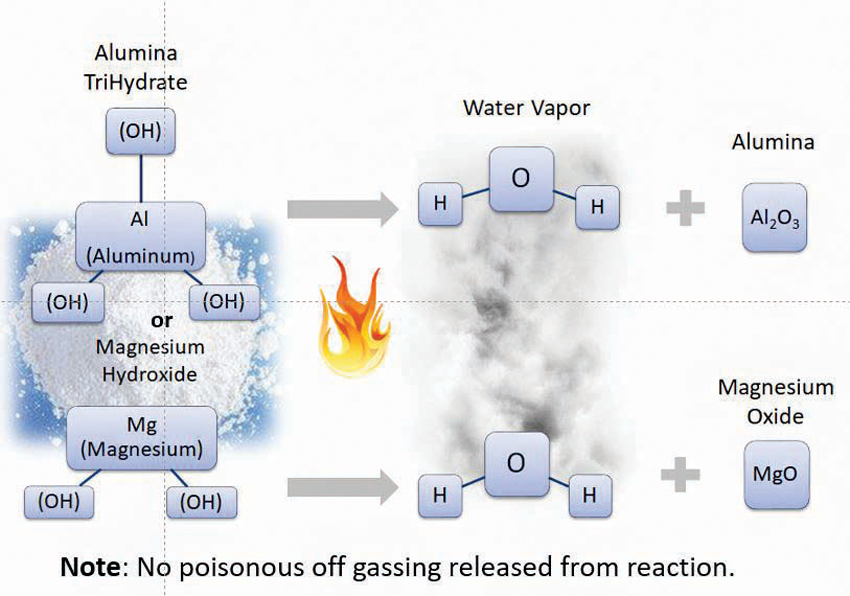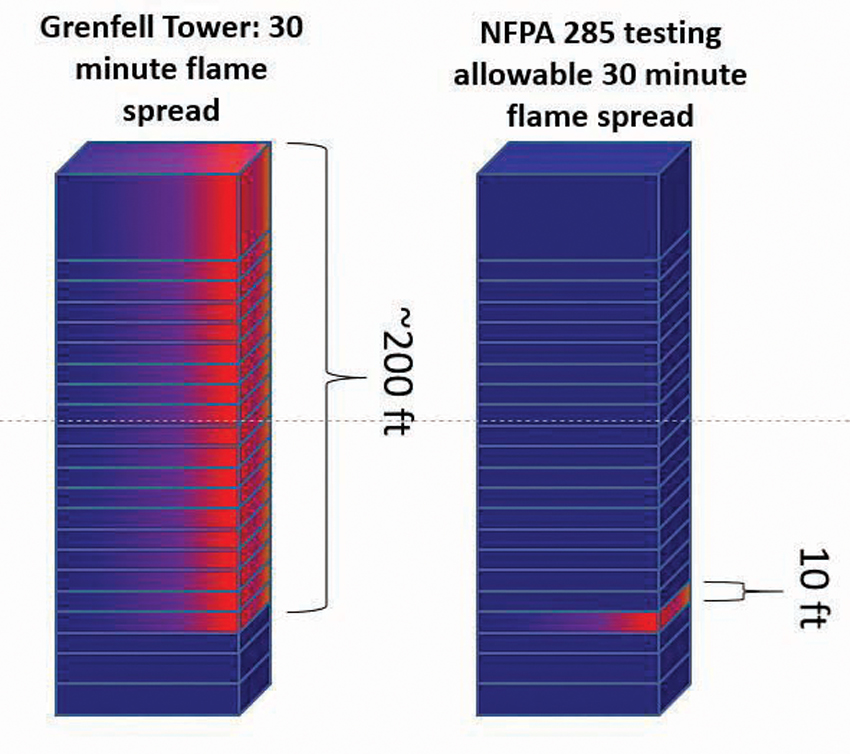Cladding Safety with Metal Composite Material (MCM) and the NFPA 285-19
Learning Objectives:
- Differentiate between metal composite materials made with a flame-retardant (FR) core and MCMs with a standard core (typically polyethylene (PE)), and how the two products respond to fire.
- Review the history and details of the NFPA 285 test for flame propagation in wall assemblies, and the new sample construction requirements added to the 2019 version.
- Evaluate the circumstances under which an exterior wall assembly is subjected to the NFPA 285 testing requirement.
- Compare different kinds of weather-resistive barriers and insulation, and how they impact the full assemblies’ ability to pass the NFPA 285 test.
- See how Engineering Judgements can be an acceptable alternative to NFPA 285 testing.
Credits:
This course is approved as a Structured Course
This course can be self-reported to the AANB, as per their CE Guidelines
Approved for structured learning
Approved for Core Learning
This course can be self-reported to the NLAA
Course may qualify for Learning Hours with NWTAA
Course eligible for OAA Learning Hours
This course is approved as a core course
This course can be self-reported for Learning Units to the Architectural Institute of British Columbia
The demand for high-performance, durable, aesthetically pleasing, and energy-efficient buildings has led to building envelope designs that incorporate combustible materials such as cladding, insulation, and weather-resistant barriers.
Charged with protecting the public health and safety of building occupants and providing safeguards from hazards associated with the built environment, the International Building Code (IBC) mandates all building systems and materials meet prescribed requirements and undergo relevant testing. The IBC outlines the minimum requirements to protect the public health and safety of building occupants, while avoiding both unnecessary costs and preferential treatment of specific materials or methods of construction. A large portion of the code deals with fire prevention and mitigating fire risk.

Photo courtesy of Robert Stefanowicz Photography/3A Composites
The metal composite cladding on the BNW Pavilion, located adjacent to the Emily Carr University of Art + Design in Vancouver, helped the structure meet updated fire propagation test protocols.
For wall assemblies in particular, systems containing combustible materials must be tested and demonstrate a certain level of resistance to fire spreading. An intermediate-scale fire test, National Fire Protection Association (NFPA) 285 is the Standard Fire Test Method for Evaluation of Fire Propagation Characteristics of Exterior Non-Load-Bearing Wall Assemblies Containing Combustible Components. NFPA 285 is a code-required standard and a key component of exterior wall design testing.
In order to help eliminate some of the complexity and confusion surrounding these designs, in addition to knowing when an NFPA 285 test is required, it is helpful for architects and specifiers to better understand the impact of material choices in the metal composite material (MCM) wall assembly.
For starters, the IBC does not define noncombustible or combustible. This terminology is defined by the NFPA in the Life Safety Code as follows: noncombustible is a material that cannot ignite or burn, cannot support combustion, and cannot release flammable vapors. Examples include brick, stone, steel, and mineral wool. All other materials are considered combustible. Product examples include phenolic panels, HPL, MCM , foam plastic insulation, and fiberglass insulation, and are tested per the American Society for Testing and Materials ASTM E136 standard test method.
It’s important to understand that many common products—e.g., desks, blinds, wood, plastic, most furniture, and flooring are combustible—but not all combustible items have the same burning characteristics.
For example, when evaluating the combustible characteristics of MCM, it’s important to differentiate between the different types of materials sandwiched in between the metal. The main options are a fire-retardant (FR) core and “standard” polyethylene (PE), which is a thermoplastic product.
The FR core utilizes the addition of minerals, such as alumina trihyrdrate or magnesium oxide, that effectively break down when subjected to extreme heat. This releases water vapor, helps suppress the fire, and causes the material to self-extinguish once the flame source is removed.
On the contrary, PE’s solid plastic core serves as a continuous fuel source enabling flames to spread vertically up the wall assembly. Standard core MCM (PE) does not pass NFPA requirements and has been identified as a significant source in multiple building fires.

Image courtesy of the Metal Construction Association
The flame-retardant core in a metal composite material panel incorporates alumina trihyrdrate or magnesium oxide, which breaks down when exposed to extreme heat. This releases water vapor and helps suppress the fire.
High-Rise Fire Events
In 2017, the tragic London Grenfell Tower fire ultimately took the lives of 72 people, with more than 70 others injured. Exacerbated by the absence of sprinkler systems and fire egress routes, what started as a malfunctioning fridge-freezer on the building’s fourth floor was fueled by plastic insulation and aluminum composite rainscreen cladding with a PE core. Unbroken air space in the building enclosure resulted in the chimney effect accelerating flame spread. To make matters worse, residents had propped open the stairwells, further accelerating flame spread.
As related by Daniel A. Martin, P.E., CFEI, CVFI, a fire protection engineer with Jensen Hughes, in a recent METALCONLive! webinar entitled “Cladding Safety in Light of Global Fires,” construction details that contributed to the Grenfell fire included multiple types of exterior insulation such as polyiso and phenolic, MCM sheets with a PE core containing no FR additives, cavity barriers not in place or continuous around window openings where required by code, and exterior wall geometrics creating large air gaps behind the MCM panels.
This tragic perfect storm enabled the fire to spread significantly in a short period of time. According to the NFPA 285, an acceptable wall assembly requires the fire to spread less than 10 feet from the window opening within 30 minutes.
Becauses MCMs with a PE core are unable to pass the NFPA 285 test, this had effectively banned their use in the U.S. for high-rise construction, or on panel installations higher than 40 feet.
Prior to the Grenfell Fire, however, their use was permitted in the U.K. MCM could bypass similar full-scale tests as long as the wall assembly components, when tested individually, passed small-scale combustibility tests. In contrast, NFPA 285 stipulates that individual assembly components must be tested as whole system.
A number of significant fires have also occurred in Dubai, most notably the Marina Torch fire in 2015 and the Tamweel Tower in 2012. At the time, the Marina Torch, 79 stories high, was one of the tallest residential buildings in the world. Started by a barbecue grill on the 51st-floor balcony, a total of 101 apartments were damaged as the fire extended up 28 stories to the top of the building.
The latter fire was started by a discarded cigarette butt that fell on a pile of waste, eventually reaching the aluminum composite panel cladding. The fire lasted five and a half hours, spread to the interior residential units, and falling/burning debris caused a number of cars parked below to catch fire. In the aftermath of the Tamweel Tower, Dubai banned the use of MCM panels with a PE core.
Pointing out the danger of fires reaching the point of flame propagation in a white paper entitled Building Exterior Wall Assembly Flammability: Have We Forgotten the Past 40 Years?, fire protection engineer John Valiulis, P.E., technical director of the nonprofit International Firestop Council, states that falling/burning debris can interfere with, or even prevent, firefighters' access to a burning building. “It can damage or destroy firefighting equipment… it can block, or make very hazardous, the egress path for occupants trying to escape from the building.”
In comparison to these European and Middle Eastern fires, it’s important to note that North America has had no catastrophic fires due to stringent and successful IBC code requirements. While there was a major fire in Las Vegas attributed to Exterior Insulation and Finish System (EIFS) cladding, and one in New Jersey fueled by panels with a PE core, both fires were of low consequence with no injuries, and occurred more than 15 years ago.
In a September 2017 NFPA Journal article, Angelo Verzoni writes, “The absence of severe exterior wall assembly fires in the U.S. seems like a testament to the successes of North American codes and standards like NFPA 285.”

Image courtesy of the Metal Construction Association
In the London Grenfell Tower fire, the fire spread approximately 200 feet within 30 minutes. To pass the NFPA 285 test, a fire cannot spread more than 10 feet from the window opening within the same period of time.
The Evolution of NFPA 285
Giving a little background on the prelude to NFPA 285’s development, the energy crisis of the 1970s led to increased exterior insulation applications. By the end of the decade, the Society of Plastics Industry developed a full-scale fire test. Then, in 1988, the Uniform Building Code adopted UBC 17-6, the Method of Test for the Evaluation of Flammability Characteristics of Exterior, Nonload-bearing Wall Panel Assemblies Using Foam Plastic Insulation. In the early 90s, further testing, and the desire to have better control for the test, led to a reduced, intermediate-scale test, which then led to an updated UBC 26-9, adopted in 1997. One year later, in 1998, the NFPA adopted UBC 26-9 as NFPA 285.
As early as the inaugural version of the IBC (2000), NFPA 285 testing was required for aluminum composite material (ACM), insulated metal panels (IMP), and foam plastic insulation (Section 2603.5) used as a component in exterior cladding assemblies (chapters 14 and 26) for Types I through IV construction. In 2009, the IBC expanded NFPA 285 testing to include Section 1408 - EIFS and Section 2612 - fiber-reinforced polymer (FRP) systems. Then in 2012, water-resistant barriers (WRB) were added in Section 1403.5, as well as high-pressure laminate panels in Section 1409.
Offering some perspective, Valiulis stated, “The fire protection engineering community in the U.S. foresaw the increasing use of combustible components in exterior wall construction decades ago. The test method, which today is titled NFPA 285... has resulted in an existing building stock with exterior walls that have exhibited a resistance to self-propagating fires.”
In NFPA 285’s latest 2019 version, a number of important changes were made, making the flame propagation testing protocols more comprehensive. These new additions include:
- Inclusion of some Types V construction
- Joint layout requirements for exterior veneer: requiring a vertical joint within 12 inches of the centerline of the window for testing exterior veneer panels with the exception of EIFS, stucco, and brick
- Requiring a vertical joint between 12 and 35 inches above the top of the window for testing exterior veneer panels with the exception of EIFS, stucco, and brick
- The specification of window header, jamb, and sill construction for the test
- Allowing wood studs for the test wall. This is relevant to alternate systems allowing inclusion of fire-retardant treated lumber, which is allowed in Type III construction in tested assemblies.
















